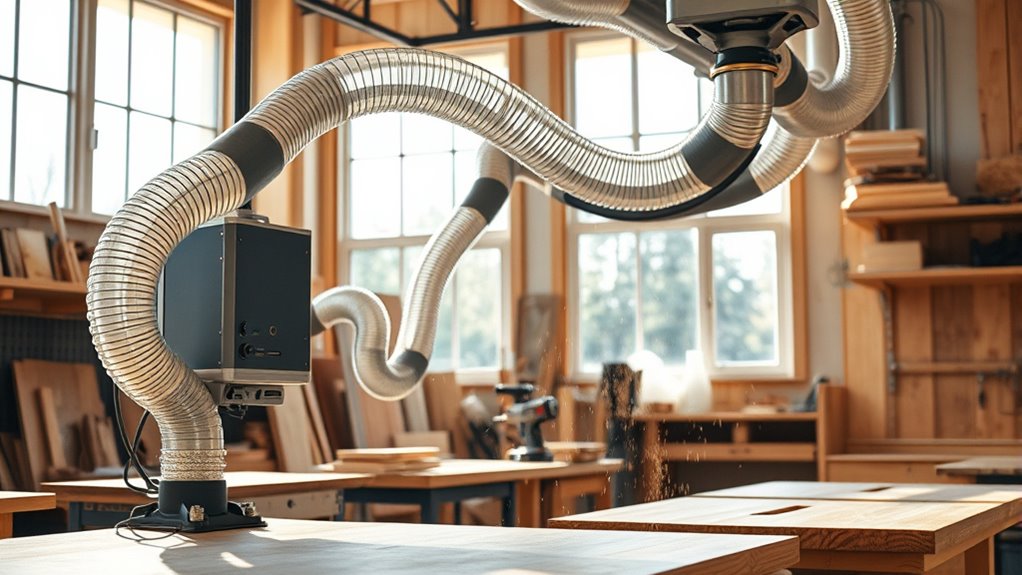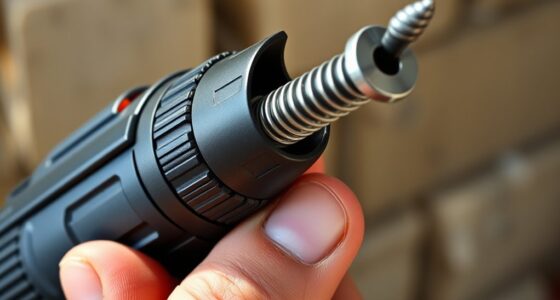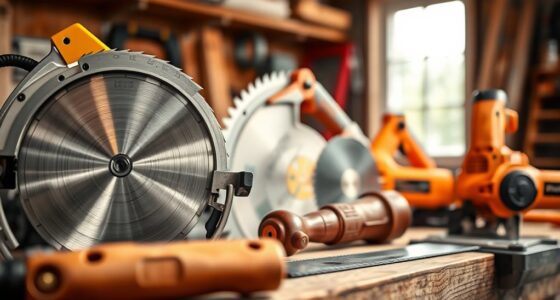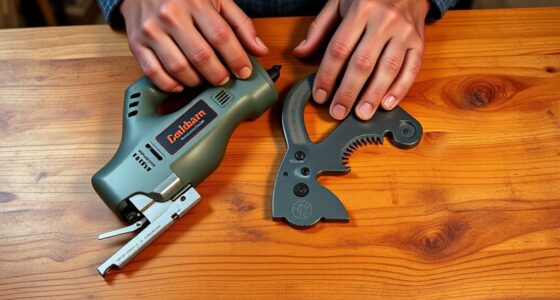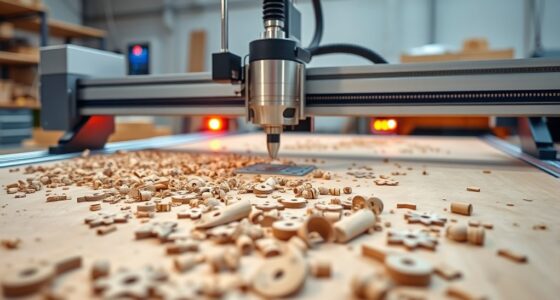To set up a dust collection system, start by identifying dust sources and choosing ideal locations for the collection units. Position inlet hoods or hoses close to dust points, ensuring all connections are secure and airtight. Turn off power before installation, wear protective gear, and organize your workspace. Regularly check, empty, and maintain filters and bins to keep the system running efficiently. Keep watching to discover detailed steps for a safe, effective setup.
Key Takeaways
- Identify dust sources and select optimal locations for collection units close to these points.
- Ensure all ductwork, hoses, and inlet hoods are securely connected and airtight.
- Turn off power before installation and use PPE to ensure safety during setup.
- Properly install and secure filters, collection bins, and system components for efficient operation.
- Regularly inspect, clean, and replace filters and components to maintain system performance.
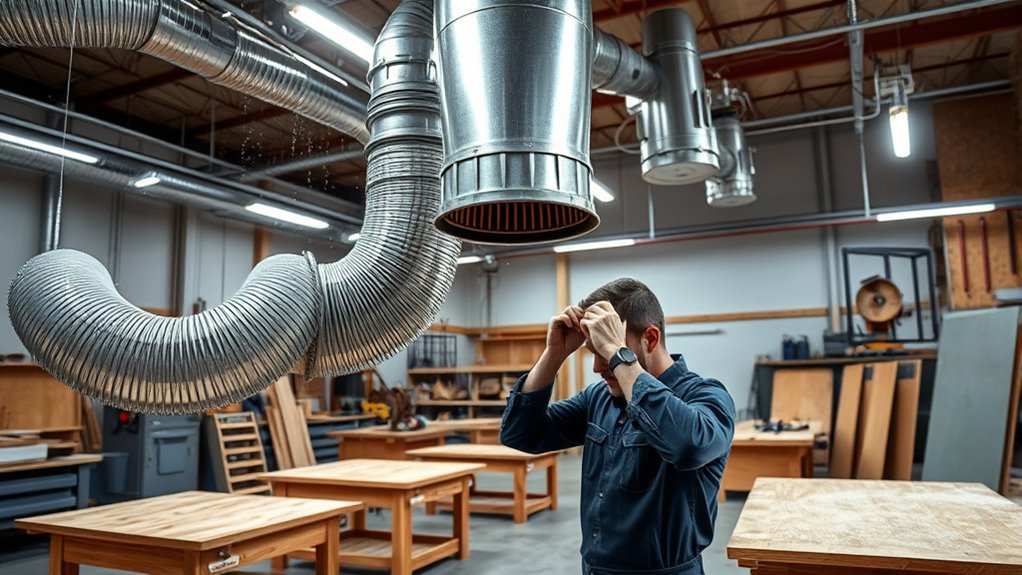
A dust collection system is indispensable for maintaining a clean and safe workspace, especially in woodworking, manufacturing, or any environment where airborne dust and debris are generated. When setting up your system, you need to prioritize effective air filtration to guarantee that dust particles don’t linger in the air, which can pose health risks and compromise visibility. Proper air filtration not only captures dust at the source but also helps in maintaining good air quality throughout your workspace. To achieve this, choose a system with high-efficiency filters capable of trapping fine particles, such as HEPA filters, especially if you work with fine or hazardous dust.
Implementing safety protocols is indispensable during the setup process. Start by evaluating your workspace to identify dust generation points and determine the best locations for your collection units. You should position the inlet hoods or hoses close to the dust source to maximize capture efficiency. Make sure all connections are secure and airtight to prevent leaks that can release dust back into the environment. Additionally, consider the airflow capacity of your system; it needs to be powerful enough to handle the volume of dust produced. An undersized system will struggle to keep your workspace clean, while an oversized one might waste energy.
Position inlet hoses near dust sources and ensure all connections are airtight for maximum efficiency.
When installing your dust collection system, adhere to safety protocols such as ensuring power sources are turned off before beginning work. Use proper personal protective equipment, like masks and gloves, during installation to avoid inhaling dust or coming into contact with sharp components. Keep the workspace organized to prevent tripping hazards from hoses or cables. Also, verify that your system’s filters are correctly installed and that the collection bins or bags are properly attached and emptied regularly. Failure to maintain these components can lead to system inefficiency or even safety hazards.
Finally, routine maintenance is essential for the longevity and effectiveness of your dust collection system. Check filters periodically and replace them as needed to maintain ideal air filtration. Clean the ductwork and collection bins to prevent buildup, which can reduce airflow and create fire risks. Establish a regular safety protocol for ongoing inspections, ensuring all parts function correctly and that dust doesn’t escape into your workspace. Properly setting up and maintaining your dust collection system not only improves air quality but also creates a safer environment, allowing you to work efficiently and with peace of mind. Regular inspections can help identify airflow issues early before they impact system performance.
Frequently Asked Questions
What Is the Ideal Air Quality Level for a Dust Collection System?
You want to maintain ideal air quality levels, so aim for dust collection systems that meet air quality standards like OSHA’s. Focus on filtration efficiency; high-quality filters capture tiny particles, preventing them from circulating. Regularly monitor your system’s performance, ensuring it effectively reduces dust. By prioritizing air quality standards and filtration efficiency, you create a safer, healthier workspace with cleaner air and minimized health risks.
How Often Should the Filters Be Replaced or Cleaned?
Your filters are the backbone of dust control, and neglecting them could turn your workspace into a dusty disaster zone, faster than you think. You should inspect your filters regularly and follow a consistent cleaning schedule—typically every few weeks or whenever you notice a drop in performance. For maximum filter maintenance, replace them when cleaning no longer restores efficiency. Staying vigilant ensures your dust collection system stays effective and your air quality remains safe.
Can a Dust Collection System Be Used for Hazardous Materials?
You can use a dust collection system for hazardous materials if it’s designed for hazardous material handling and offers chemical resistance. Make certain the system’s filters and components are compatible with the specific hazardous substances you’re working with. Properly sealing and maintaining the system is vital to prevent leaks or exposure. Always follow safety guidelines and manufacturer instructions to guarantee safe, effective containment of hazardous materials.
What Is the Typical Lifespan of a Dust Collection System?
Think of your dust collection system as a well-loved car—regular maintenance keeps it running smoothly. Typically, it lasts 10-15 years with proper filter maintenance and occasional system upgrades. Over time, filters wear out, reducing efficiency, so replacing them prolongs lifespan. Upgrading components can prevent costly repairs down the line. With attentive care, your system can serve you reliably for many years, just like that trusty vehicle.
Are There Specific Safety Certifications to Look for When Choosing a System?
When choosing a dust collection system, you should look for safety certifications that meet industry standards. Check for certification marks like UL or OSHA compliance, which indicate the system adheres to safety standards. These marks guarantee the system has been tested for proper operation and safety. Prioritizing certified systems helps protect your workspace, ensures regulatory compliance, and reduces risks associated with dust hazards.
Conclusion
Now that you’ve set up your dust collection system, you’re ready to work cleaner and safer. Remember, a well-maintained system keeps your workspace healthier and your tools running smoothly. Are you prepared to enjoy a dust-free environment that boosts your productivity? Regularly check and clean your system to guarantee it works efficiently. With these steps, you’ll create a safer, cleaner space where your projects can thrive. Don’t wait—start enjoying the benefits today!
